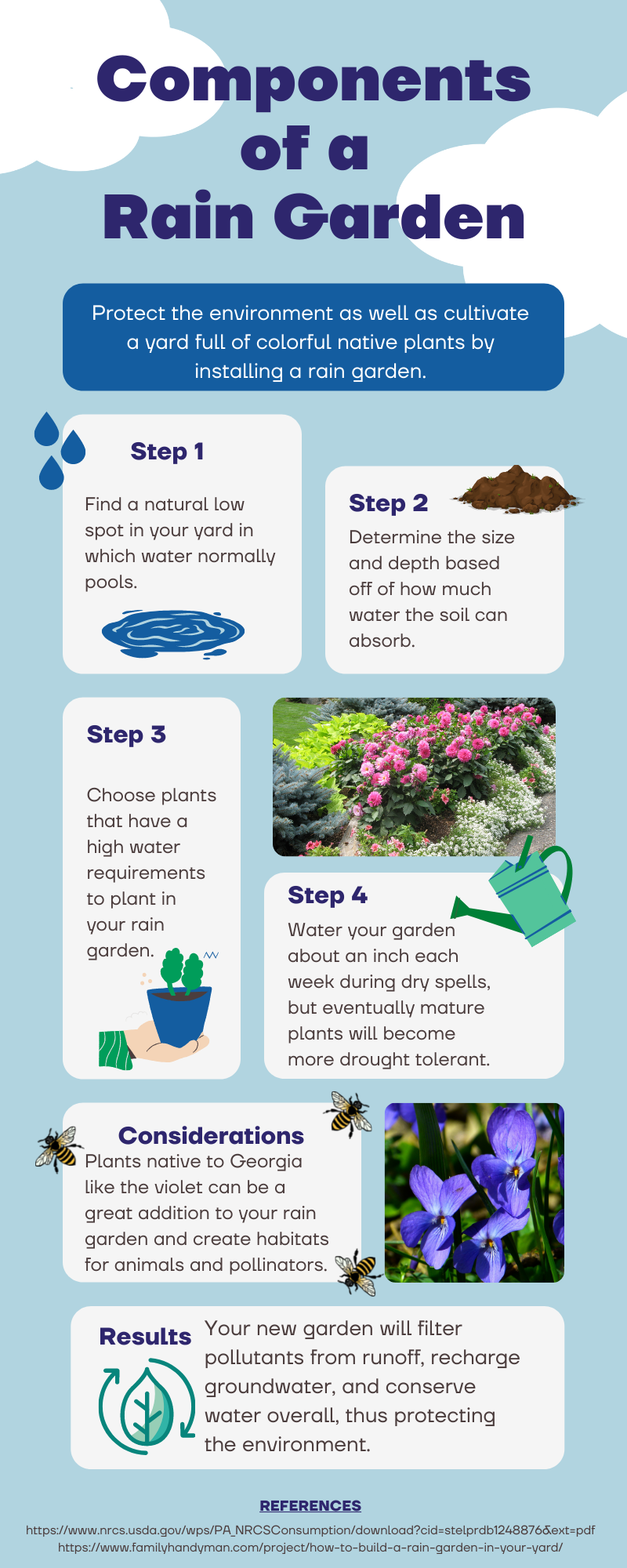Water pollution is just one of many environmental concerns affecting the state of Georgia. Harmful chemicals and toxic substances find their way into our lakes, streams, and oceans, jeopardizing the health of ecosystems around the state as well as human health. Even though this seems like a daunting issue, an answer to this problem might be sitting in your own backyard in the form of a rain garden.
Why Its Newsworthy: Rain gardens can be an effective method of water conservation and help remove pollutants from water runoff in your community.
What is a Rain Garden?
A rain garden is an area of land in which rainwater naturally pools and then slowly soaks into the ground. These gardens are often full of native plants, insects, and animals and can serve as a means of water conservation.
Rain gardens are a type of water retention feature in landscaping that allows for water runoff from storms to be absorbed slowly. These gardens are just one example of a ‘bioretention’ system that can help the land naturally capture rainwater, filter pollutants, and recharge ground water.
Since rain gardens can be an easy way to manage rainwater, some residents around Athens, Georgia, are installing rain gardens in their own backyards. City Garden Company, a landscaping company that serves the Atlanta metro area and Athens, Georgia, installs “urban nature gardens” meant to attract insects and birds as well as capture and conserve rainwater.
“It’s just a really good way of managing water on your property,” said Danielle Calenti, Operations Manager of City Garden Company. She also went on to say, “When you have a property that’s sloping and there’s a lot of water washing off of the property and down into the street or down onto a neighbor’s property, it helps to keep the rainwater on the property and make use of it.”
Without a rain garden installation, the customer’s yard could potentially flood with polluted water. This can happen because “as rainwater flows across our yards, patios, parking lots, and other hard surfaces, the water picks up oil, pet waste, fertilizer, sediments, and other pollutants,” notes the Watershed Institute in an article detailing examples of green infrastructure.
The water that would otherwise pool or drain off the property can now be slowly filtered through a garden full of native plants and river rock.
Plant Selection
The types of plants included in a rain garden can make or break its success in filtering and conserving water. These plants will have to be able to tolerate both drought and flooding.
“You just have to kind of select the plants that are tolerable of both very wet conditions and very dry conditions. And obviously, that’s quite a tall order, right? So there are plants that will tolerate that and maybe even thrive because if they can make it in those conditions, they have an advantage over other plants that can’t,” said Calenti.
Consistently wet and often flooded areas can be quite a challenge for landscapers and gardeners. Luckily, plants native to the state of Georgia – perennials, shrubs and trees – can take on that challenge. For example, perennials such as swamp sunflowers, lady ferns, and jewelweed are native plants to Georgia that can tolerate the conditions created by a rain garden.
Native plants are naturally occurring in a particular region and are the ecological basis of life in that area as well. As urbanization has destroyed millions of acres of habitat containing native plants, the remaining amounts of native plants cannot fully support wildlife populations.
Using native plants is crucial when installing a rain garden because these plants are built to survive in Georgia and withstand the wet conditions.
The Science Behind Rain Gardens
Keren Giovengo, the program manager of EcoScapes Sustainable Land Use Program at the University of Georgia Marine Extension and Georgia Sea Grant, describes the importance of rain gardens as both a challenge and an opportunity.
Giovengo describes a rain garden as a challenge because of the strenuous conditions the plants must survive as well as the initial difficulty in establishing the garden itself.
However, these gardens can also present an opportunity because “Rain gardens play an important role in sustainable landscapes because they emanate nature and are a natural way to manage stormwater runoff, a major source of pollution in our waterways and a cause of erosion, sewer overflows and flooding,” she said.
The EPA estimates that pollutants carried by rainwater runoff account for up to 70% of all water pollution.
The Groundwater Foundation notes that, “Rain gardens are effective in removing up to 90% of nutrients and chemicals and up to 80% of sediments from the rainwater runoff.” The article also goes on to say that when comparing a rain garden to a traditional garden, the rain garden allows for 30% more water to be absorbed into the ground.
Install Your Own Rain Garden
Installing your own rain garden can be a great way to reduce your impact on the environment and also help build up the natural ecosystems in Georgia.
The University of Connecticut Center for Land Use Education and Research (CLEAR) and the Connecticut Sea Grant began developing a free rain garden smartphone app called “Rain Garden App” on the app store in 2013.
“The app was developed to assist homeowners, landscapers, contractors and others through properly designing, installing and maintaining rain gardens. The UGA Marine Extension and Georgia Sea Grant EcoScapes Sustainable Land Use Program collaborated with CLEAR and a team from 13 states to develop the expanded version of the app,” said Giovengo.
This multi-state app includes video tutorials, diagrams, and other tools to help users install their own rain garden. Georgia users can also find information specific to this region such as soil drainage maps, sizing tools, and contact information for local authorities that issue permits to build or change the flow of water on your property.
Additionally, landscaping companies can be a great resource for rain garden installations as well as doing your own research.
“There’s lots of information online about how to make a rain garden, so I guess just kind of use the internet and research it well,” said Calenti. “You should be able to create a garden with all the information that’s available online.”

Carrie Jordan is a senior majoring in journalism in the Grady College of Journalism and Mass Communication and Spanish in the Franklin College of Arts and Sciences as well as pursuing a certificate in New Media and Technology through the New Media Institute at the University of Georgia.
![]()









Show Comments (1)